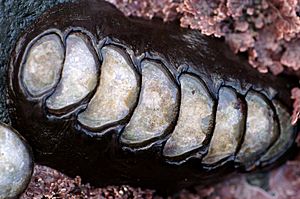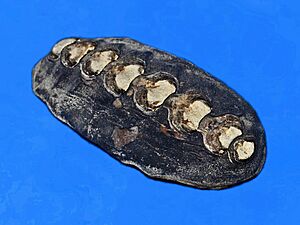Katharina tunicata facts for kids
Quick facts for kids Katharina tunicata |
|
|---|---|
 |
|
| Scientific classification | |
| Kingdom: | |
| Phylum: | |
| Class: | |
| Order: |
Neoloricata
|
| Suborder: |
Ischnochitonina
|
| Family: |
Mopaliidae
|
| Genus: |
Katharina
|
| Species: |
K. tunicata
|
| Binomial name | |
| Katharina tunicata Wood, 1815
|
|
The black Katy chiton (scientific name: Katharina tunicata) is a cool sea creature often called the black leather chiton. It's a type of chiton, which is a group of marine animals with a special shell made of eight plates. It belongs to the Mopaliidae family.
Contents
What Does It Look Like?
The black Katy chiton can grow up to 12 centimeters (about 5 inches) long. It often looks like a small, oval-shaped football. It has a tough, black, leathery band called a girdle around its body. Inside this girdle are eight strong plates that protect it.
Sometimes, the parts of these plates that you can see look like diamonds. The underside of the chiton is usually a dull orange or yellow color.
How Is Its Body Built?
When you look at the black Katy chiton from above, you can easily see its main parts. These include the mantle (a soft body layer), the girdle, and the eight shell plates. The girdle is covered with a tough, protective skin.
If you flip the chiton over, you'll see its muscular foot. This foot helps it move slowly across rocks. Gills are located on both sides of the foot, helping the chiton breathe underwater. At the front of the foot is its mouth, and at the back is its anus.
What Does It Eat?
Like other chitons, the black Katy chiton moves very slowly as it grazes on food. It mostly eats different kinds of brown and red algae, like kelp and sea lettuce. It also enjoys tiny diatoms, which are a type of algae that grows in a crust on surfaces.
Sometimes, these chitons will also munch on sponges, small barnacles, tiny worms called spirobid polychaetes, and bryozoans (small colonial animals).
However, the black Katy chiton also has its own predators. These include sea urchins, leather stars (a type of starfish), and birds like black oystercatchers and glaucous-winged gulls. Humans also sometimes eat them.
Life Cycle and Reproduction
Black Katy chitons usually have separate male and female individuals. They become ready to reproduce when they are about 35 millimeters long.
When the weather gets cooler in the fall, it helps their reproductive organs grow. Then, in the spring, as temperatures rise, they start making eggs and sperm. Males release their sperm into the water first. This signals nearby females to release their eggs, which then get fertilized in the ocean.
Young chitons prefer to settle and grow where there is coralline algae. Most black Katy chitons will go through this reproduction cycle about three times in their lives.
Where Do They Live?
You can find the black Katy chiton in many places across the northern Pacific Ocean. Their range stretches from the Kamchatka Peninsula in Russia, across the Aleutian Islands, and all the way down to southern California in the USA.
Their Home Habitat
These chitons live in areas between the high and low tide marks, called intertidal zones. They can also be found in deeper waters, up to 40 meters (about 130 feet) deep. They especially like rocky shores where there are strong waves.
What's special about the black Katy chiton is that it can handle direct sunlight. Many other chitons prefer to stay hidden from the sun.
The places where these chitons live can be affected by human activities. Things like pollution from factories, logging, mining, and building along the coast can harm their habitat. Too many people visiting or collecting them can also be a problem.
Scientists are still learning how climate change might affect these creatures and their homes. In the USA, this species is protected under the Coastal Zone Management Act.
As Food for People
Long ago, the indigenous peoples of California would cook and eat the black Katy chiton. They would prepare it over hot coals or in a special underground oven called an earth oven.


